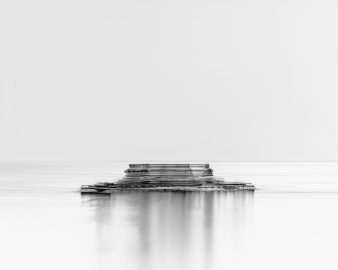Vessels
Vessels is the genesis of a delicate interplay of time and motion — all-night-long exposures of Sailing Yachts, Motor Yachts, and Cruise Ships, that set-anchor each summer in the bay near where I live on the Ligurian Sea. Like a twinkling cluster of stars floating in the middle of an inky-black sea, they drift silently and almost imperceptibly around their mooring at the changeable whim of the wind and currents.
As the last trace of twilight in the sky turns from dark blue to black, I prepare my large-format film camera for the night-shift. Once physically mounted on the tripod, I can only set the stage for whatever photographic gifts might come. After leveling the horizon, adjusting my framing to position the ships’ bow towards the centre of the ground glass, and stopping down the aper- ture of my lens to f/64, I’m then ready to remove the dark-slide protecting the light-sensitive sheet-film in my negative holder and depress the snake-like shutter-release to start the photograph. Over the next seven or eight hours of darkness, nothing but the point source of artificial light emanating from the yacht’s superstructure, along with the gentle build-up of any moonlight reflected off the surface of the sea, register on my negative.
The ship’s slow and variable circum-navigation around its anchor, helmed only by the elements, plots an orbit of random and overlapping arcs, recorded in continuous detail but without any discernible beginning or end. With every wave and gust of wind, the vessel yaws up and down and to and fro, oscillating like an electrocardiogram. More subtle still is the faint trace of light made by the small tenders, ferrying guests back and forth to the port, and the distant glow of cruise ships and container vessels ‘painting’ the horizon during the course of their nocturnal crossings. Time elapses without any visible gauge to measure its passing until the first hint of daybreak becomes perceptible to the east, and finally it’s time to close the shutter, before Earth’s rotation once again catches up with the Sun and threatens to wash-out the still invisible image yet to reveal itself on my negative. In contrast to Henri Cartier-Bresson’s ‘desicive moment’, these photographs are made over the course of many hours, rather than mere hundredths of a second. From an aesthetic perspective the overwhelmingly majority of my long-exposures end in failure, however, they all nevertheless reveal something that the human eye cannot see — a visual record of an otherwise invisible architecture of time.
Printed in the negative as a facsimile enlargement of the original exposed sheet of film, these photographic ‘recordings’ at first resemble works made with graphite, charcoal or Indian ink and remind me, at least conceptually, of the playful linear drawings I used to make with an Etch-A-Sketch toy as a child.
Like a willing insomniac, my summer nights invariably amount to lying on the hammock I set-up next to my camera on the roof terrace, and staring out at an endlessly changing sea until shortly before daybreak. This self-imposed ritual has provided me the luxury of slowing down from the frenetic pace of life, and to reflect on the dichotomy of the seen versus unseen as a metaphor for how man-made objects re-contextualize and impact our natural environment. Punctuating what appears from afar to be an untarnished and infinite body of water, the strange geometries that populate these photographs; architectural, spherical, almost otherworldly in origin, echo a state of imbalance with the natural world and question the sustainable co-existence of man and his machines — transient invaders of a primordial seascape, essentially unchanged since the dawn of time.
– Damion Berger

























